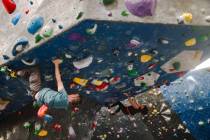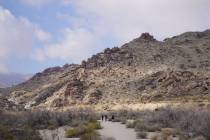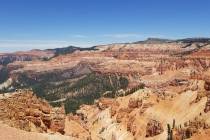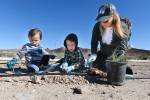Volunteer guides lead tours through Clark County Wetlands Park
On a beautiful cloudless day in January, children kept drawing the volunteer guides leading the Wetlands Park Weekend Walk back to three subjects.
Where are the rapids, and will we see them?
Are there animals, and can we touch them?
Confirmations of synonyms for animal feces.
The answers were, "Yes, yes, yes, no and, as it turns out, kids are veritable Roget's Thesauruses of animal waste.
The Weekend Walk program is operated by an all-volunteer staff and was started last spring primarily to provide an educational opportunity for elementary school children and their parents.
"Our mission for it is just to familiarize people with the park," said Christie Leavitt, curator of education for the Clark County Wetlands Park, "And to give them some idea of what a wonderful resource they have that's close to home."
Some hikers were in the park for the first time, and they were surprised by the size and beauty of the site near the east end of Tropicana Avenue. Others, with the help of the guides, were seeing the park with fresh eyes.
The valley's largest public park is home to a variety of wildlife, and even in the winter during the bright daylight, many different animals were seen. Kids and adults alike were delighted to watch coots make repeated dives to the bottom of ponds in search of food. Quail and rabbits dodged into the tall reeds in front of the group.
"On recent hikes, kids have seen horned owls, and they were all excited the other day when they saw a great blue heron taking a bath," Leavitt said. "This morning kids saw six turtles sunbathing on a rock."
Many of the animals that call the park home are nocturnal, so the guides are limited to showing the kids tracks or scat of coyotes and other night creatures, but there are exceptions.
"A first-grade class that was out here last year was looking at raccoon tracks, and the volunteer was asking them where they thought the raccoons had been going and what they had been doing," Leavitt said. "A little voice in the back said, 'Look at that kitty,' and there was the raccoon in a tree."
Another subject that the kids kept returning to was the question of edible plants in the park. The guides were quick to point out that while there were some plants that had been used for food and medicinal purposes by the Native Americans, foraging in the park was best left to the wildlife.
As an example, they pointed out the mistletoe, a parasitic plant with berries poisonous to humans but a treat for many birds. The birds help propagate the plant by eating the berries and passing the undigested seeds, sometimes at a great distance from the parent plant.
The guides put the kids on the lookout for p hainopepla, one of the birds that does this. Eventually a few were spotted in the upper branches of a tree, and everyone was excited to take a turn with the binoculars to check out the bird's spiky crest and bright red eyes.
"The program was suggested by our volunteers," Leavitt said. "We have a more formal program on Tuesdays and Thursdays for schoolchildren. We've developed a field trip curriculum for kids in kindergarten through fifth grade."
Leavitt said that for the younger students, the trip is essentially a nature hike in which the children are encouraged to experience the park through all of their senses. The older ones use equipment such as binoculars, magnifying glasses and thermometers and take notes on prepared questions.
The Saturday hikes have a more open structure. In response to the children's questions about edible plants, volunteer Merlyn Herold showed them quail bush, also called saltbush, that the Native Americans used to season food with. The Henderson resident then took advantage of the unseasonably warm day to point out how natural processes caused it to be about 10 degrees cooler near a group of cottonwood trees.
Merlyn's wife, Lynn, who shared the guide duties, explained that the wire mesh around some of the trees was there to protect them from the bank beavers that lived nearby. Unlike northern beavers, bank beavers do not built lodges in the middle of ponds. They burrow underwater to dig out homes in the banks of rivers.
Near the end of the nearly three-hour hike, the group was surprised to round a corner and find a snowy egret wading a few dozen feet away in a brook.
"A lot of kids are becoming more urban and spending more time indoors," Leavitt said. "They've never seen anything wild, and for them to see an animal that's not anyone's pet is really quite something for them."
While the hike is designed for elementary school-aged children and their parents, it isn't limited to them. Vicky Sneed, who moved to the valley three years ago and is still finding all the outdoors things to do here, went on the trip without any children accompanying her.
"The kids were a trip," Sneed said with a laugh. "My favorite part was the babbling brooks and the wildlife. The egret flying across was awesome."
Eleven-year-old John Rodriguez agreed that the wildlife was awesome.
"I always like looking at strange animals," John said. "I like the nature and the lakes. I want to come back again soon."
Wetlands Park Weekend Walk events are scheduled from 9:15 a.m. to noon Feb. 25, March 10 and 24 and April 14 and 28 at the Clark County Wetlands Park, 7050 Wetlands Park Lane. The walks are free, but space is limited and registration is required. For more information and to register, call 455-7522.
Contact Sunrise/Whitney View reporter F. Andrew Taylor at ataylor@viewnews.com or 380-4532.































